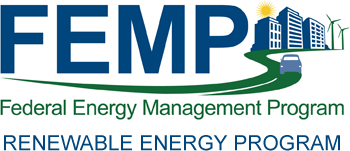Introduction
Within This Page
- Introduction
- Description
- Application
- Operation and Maintenance
- Special Considerations
- Relevant Codes and Standards
- Additional Resources
THIS PAGE SUPPORTED BY THE
A fuel cell operates like a battery, but does not run down. Instead of charging, it is an electrochemical device that uses oxygen and a readily replenished fuel, such as hydrogen, to produce electricity. Individual fuel cells are stacked in a module to produce the desired energy output, much like commercial batteries use an array of individual cells. With heat and water as the primary byproducts, fuel cells are virtually pollution-free and have more than two times the efficiency of traditional combustion technologies, which typically have an efficiency rate of 33% to 35%. As long as fuel is supplied to the fuel cell, energy in the form of heat and electricity will be produced. Fuel cells can provide power for a range of applications—from laptop computers to utility power plants. A power converter can convert the direct current (DC) power produced by the fuel cell into alternating current (AC) power that is compatible for use by the facility and the utility. According to the U.S. Department of Energy (DOE) Office of Energy Efficiency and Renewable Energy (EERE) Fuel Cell Technologies Office, when the heat from the fuel cell is captured and used in combination with electrical power (such as combined heat and power), fuel cells can have efficiency rates between 70% and 85%.
One of the advantages of fuel cells is that hydrogen fuel can be derived using a variety of domestic resources such as biomass, water electrolysis, natural gas, propane, and methanol. Hydrogen generated by water electrolysis, which is the splitting of water molecules into hydrogen and oxygen using electricity, can be beneficial when used in combination with variable renewable energy technologies such as solar and wind. When the electricity used for water electrolysis is produced by a variable renewable energy source, the hydrogen stores the unused energy for later use and is classified as a renewable fuel and energy resource.
Fuel cells have been used for many years in the space program to provide electricity and drinking water for astronauts as well as industrial applications. The applications are classified into the following three categories: transportation, stationary power stations, and portable power. This overview focuses on stationary power station applications.
Benefits and advantages of fuel cell technologies include:
- Near zero emissions at the point of operation
- Reduction in current and future electricity costs through the efficient use of renewable energy technologies
- A high-quality, reliable, and consistent power supply as long as fuel is supplied
- Higher electrical efficiency than traditional combustion power supplies
- Combined heat and power installations of fuel cells, which further increases efficiency by utilizing the heat generated by the fuel cell for building heating needs
- Fuel-flexibility, enabling the use of a variety of domestic energy sources (e.g. hydrogen, natural gas, and methanol)
- Silent operation 24 hours per day, 7 days per week
- A wide range of applications to choose from.
This overview is intended to provide specific details for Federal Agencies considering fuel cells and renewable hydrogen as part of a construction project. Further general information is available at U.S. Department of Energy (DOE) Office of Energy Efficiency and Renewable Energy (EERE) Hydrogen and Fuel Cell Technology Basics.
Description
A fuel cell system is made up of several key components that may include:
- Fuel delivery module (from a fuel processor or a hydrogen storage tank)
- Fuel cell stack
- Balance of plant
- Power electronics module
- Control system.
The fuel delivery module is what governs the delivery of the hydrogen to the fuel cell stack and is needed in most fuel cell installations. Hydrogen is produced and purified on demand for the fuel cell system by a fuel processor. The fuel processor then converts the fuel supply (e.g. natural gas and biogas) into a hydrogen-rich stream, which is purified to an acceptable purity level for the fuel cell stack. Maintaining the required hydrogen purity is critical in these systems. Certain contaminants in the fuel supply act as poisons to the fuel cell stack and drastically shorten the lifetime of the fuel cell system. As discussed below, there are several types of fuel cell designs, and, as a result, the hydrogen purity specification for each design can vary. Hydrogen can also be delivered and stored onsite in a tank to power the fuel cell system.
The fuel cell stack is where the electrochemical process of converting hydrogen into electricity and heat occurs. It is surrounded by a various balance of plant components (e.g. valves, air blowers, and sensors) to monitor and regulate system operation. The hydrogen is fed into the anode side of the fuel cell stack, while air is fed to the cathode side of the fuel cell stack to sustain the electrochemical reaction. For information on how a fuel cell works, the EERE Fuel Technologies Office provides an animated illustration of fuel cell operation.
The electricity produced by the fuel cell stack is DC. A power electronics module is typically incorporated into the fuel cell system design to manage the power output and quality from the fuel cell system. If the end user requires an AC output, the conversion from DC to AC power is accomplished in the power electronics module. A control system is used to operate the entire fuel cell system and typically interfaces with the electrical system at the customer site.
Types and Costs of Technology
Of the various types of fuel cells, four are commercially available: phosphoric acid, polymer electrolyte membrane, molten carbonate, and solid oxide.
Phosphoric Acid Fuel Cells
Phosphoric acid fuel cells systems are currently being used to provide power to office buildings, hospitals, nursing homes, banks, schools, and utility power plants. The phosphoric acid fuel cell is considered the first generation of commercial fuel cells and is one of the most mature cell types. These cells have an operating temperature of about 100°C to 220°C, and achieve an electrical efficiency of about 37% to 42% alone, with up to 85% efficiency when used in combined heat and power applications. This type of fuel cell is typically used for distributed power generation applications that provide primary power and heat to facilities. These are large fuel cell systems that provide 100 kilowatts (kW) to 400 kW of power and are more tolerant of fuel impurities than polymer electrolyte membrane fuel cells.
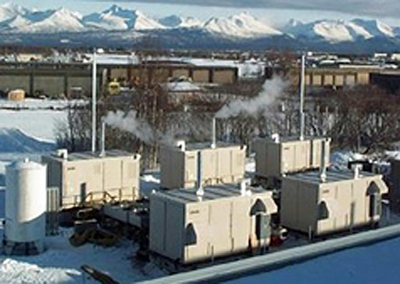
At the Anchorage mail processing center in Alaska, the United States Postal Service and the Chugach Electric Association worked together on one of the largest fuel cell projects in the world. In this project, five 200 kW phosphoric acid fuel cells were installed along with a unique software control package to run the units.
Molten Carbonate Fuel Cells
Molten carbonate fuel cells are currently used for electrical utility, industrial, distributed generation, and military applications. They operate at high temperatures (600°C to 700°C) and do not require an external fuel processor. Depending on system size, molten carbonate fuel cells can provide 300 kW to 3 megawatts (MW) of power and are well-suited for large applications. Alone they have an efficiency rate approaching 65% and when used in combined heat and power applications, the efficiency increases to 85%.
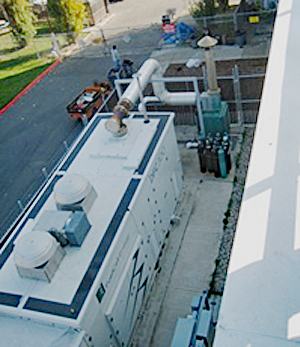
Molten carbonate fuel cell system at a postal processing facility in San Francisco.
|
Documented by the County of Alameda in California, the results of the Santa Rita jail fuel cell power plant project include:
Powered by natural gas, the 1-MW fuel cell is a source of ultra-clean power at the Santa Rita jail. This installation combined with the previously installed rooftop solar power array and energy efficiency upgrades will reduce power purchases as much as 80% during peak-demand summer months. This translates to avoided greenhouse gas emissions of 3,200 tons annually, equivalent to planting approximately 900 acres of trees. |
Polymer Electrolyte Membrane
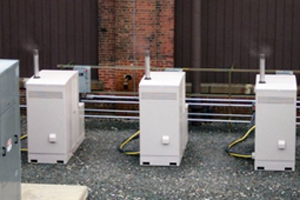
Three plug power polymer electrolyte membrane fuel cells at the Watervliet Arsenal, Department of Defense, Army.
Polymer electrolyte membrane fuel cells—also called proton exchange membrane fuel cells—need only hydrogen, oxygen from the air, and water to operate and do not require corrosive fluids like some fuel cells. This type of fuel cell runs at low temperatures, usually around 80°C, with electrical efficiencies of about 45%. In addition, polymer electrolyte membrane fuel cells are the primary candidate for automotive and small stationary applications. They are used in back-up power applications, critical loads, high quality power, and emergency service equipment. They also provide between 1 kW to 100 kW of power for applications and have a quick start-up capability.
Solid Oxide Fuel Cells
Solid oxide fuel cells operate at very high temperatures, between 700°C to 1,000°C (1,830°F). They are currently used in residential and commercial applications, providing 1 kW to 2 MW of power depending on the size. High-temperature operation removes the need for precious-metal catalyst and like molten carbonate fuel cells, enables internal reformation of fuels; thereby reducing the cost of the fuel cell system. High-temperature solid oxide fuel cells are being demonstrated for distributed generation, auxiliary power, and electric utility applications.
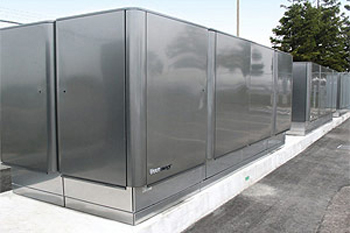
FedEx chose its Oakland, California, hub for an installation of five 100 kW Bloom Energy solid oxide fuel cells. Coupled with existing solar power at the site, the project provides reliable, continuous power and is expected to achieve a return on investment in five years.
Photo by Bloom Energy
An overview comparison of fuel cell technologies is available from the EERE Fuel Technologies Office as a fact sheet .
Technology Costs
The installed cost of a fuel cell system will depend on the type of fuel cell system selected, configuration, and size. Cost information can be obtained by contacting a fuel cell manufacturer. DOE's Fuel Cell Power Model can be used for a preliminary evaluation of using fuel cells at the site location. Installation costs of a fuel cell system can range from $5,000/kW to $10,000/kW.
Application
Fuel cell systems have a wide range of applications because they are fuel flexible and can be sized to accommodate energy needs. Stationary fuel cell power plants are typically used in distributed generation and combined heat (or cooling) and power, both critical and primary power applications.
The two best applications for stationary fuel cell systems are combined heat and power and critical backup power. In order to maximize the efficiency of a fuel cell system, utilizing the heat generated by the fuel cell stack as well as the electricity is important. The heat generated by a fuel cell can be utilized in building heating schemes though the use of hydronic loops and other means. In combined heat and power applications, the fuel cell system can be configured to follow either the heat or electrical load requirements of the site depending on end-user requirements.
Providing backup power for critical computer and communication systems is another common application for fuel cell systems. Fuel cell systems can be configured for grid-independent operation to provide continuous and seamless operation of critical systems in the event of an electrical grid failure.
Fuel cell applications only count toward Federal energy requirements when the hydrogen used with the fuel cell is generated from renewable energy sources. For Federal facilities, combining other renewable energy technologies, such as wind or photovoltaics, can provide renewable hydrogen and reliable power. These covered in other technology resource pages in this guide:
Economics
Site-specific economic analysis is critical for evaluating if a particular site is suitable for installation of a fuel cell system. Key factors include grid electricity costs, delivered fuel costs (typically natural gas), site load profiles, and availability of financial incentives. Two of the most important drivers for economic viability are: 1) the premium placed on backup and reliable power for a given facility, and 2) the spread in cost between natural gas provided to a facility and the cost of electricity purchased from the grid, otherwise known as the "spark spread".
For locations with relatively low natural gas costs and relatively high electricity costs, fuel cell systems will have a faster payback period and may provide a substantial additional revenue stream when net metering applies. NREL provides the Fuel Cell Power Model, a downloadable economic calculator, which can be customized to estimate costs for specific building applications, incentives, and utility rate structures. This model is available on the U.S. Department of Energy's (DOE) hydrogen analysis website. In addition, information on specific financial incentives for fuel cell systems can be found on the Database of State Incentives for Renewables & Efficiency® (DSIRE®).
Assessing Resource Availability
For operation of a fuel cell system, access to a reliable fuel source and atmospheric air is required. Depending on fuel cell type, access to a natural gas, hydrogen, or methanol distribution network is required. If the use of renewable hydrogen is desired, access to a renewable energy source is needed. If hydrogen is to be produced by electrolysis, purified water and an electrolyzer are needed. The commercial supplier can help determine the fuel requirements for a particular fuel cell system.
Procurement Considerations
When procuring commercial fuel cell systems, system certifications should be considered. Most commercial systems will carry a certification mark, such as UL, CSA, and CE, that shows that the fuel cell system meets relevant safety requirements. Fuel cell systems are typically rated for indoor or outdoor use.
Operation and Maintenance
Many fuel cell system manufacturers offer a variety of ownership, leasing, power purchasing agreements, and warranty options. End-user ownership of a fuel cell system requires the most responsibility for operation and maintenance (O&M) of the fuel cell system. Leasing arrangements typically require the end user to be responsible for fuel purchase and delivery along with lease payments, while the initial capital, installation, and maintenance costs are assumed by the leasing agent. Power purchasing agreements require the least amount of end-user responsibility with the power purchasing agreement agent handling the O&M costs while the end user agrees to purchase power from the agent. Fuel cell manufacturers can provide system-specific information on O&M costs.
Special Considerations
The following are important special considerations for fuel cell systems.
Interconnection
A fuel cell that will be connected to the local utility grid must meet interconnection requirements of the local utility. Many states or localities have guidelines that require interconnection of many customer-owned power projects. Some guidelines limit the size of a project that can be interconnected or restrict the types of technologies that can be connected. A Federal agency should confirm early in the discussion with the utility if it can sign the utility interconnection agreement as there have been some cases where utility indemnification clauses prevented an agency from legally signing the agreement.
Rules also vary for net metering of interconnected systems, including availability of net metering, terms of the tariff, and the size of eligible systems. In some cases, the rules for fuel cells may vary from other energy sources.
The Federal Energy Management Program (FEMP)'s Guide to Integrating Renewable Energy in Federal Construction has more information on interconnection requirements and net metering.
Permitting
The codes and standards for stationary fuel cells are relatively well defined. If the authority having jurisdiction is not familiar with these codes and standards, it may be beneficial to meet with them prior to submitting a permit application. This meeting would be an opportunity to provide a technology overview, explain how the project complies with all codes and standards, and answer any questions that they may have. Using published case studies that show examples of installations of the same technology may also be helpful while meeting with the authority. A Federal facility usually issues permits through the site fire marshal or another controlling authority.
Meeting codes and standards requirements for the hydrogen storage required to power the fuel cell could be one of the more difficult permitting issues. The gaseous hydrogen storage systems typically have to meet separation distances specified in NFPA 2 Hydrogen Technologies Code 2011 edition. These separation distances can be difficult to meet for hydrogen storage systems located on relatively small plots of land. For example, for a gaseous hydrogen storage system, the separation distance from the lot line can be up to 45 feet.
Relevant Codes and Standards
There are standards provided by the Institute of Electrical and Electronics Engineers (IEEE) that set requirements for connecting distributed resources with electric power systems. Fuel cells are considered a distributed resource. The IEEE standards that apply to connecting distributed resources are:
- IEEE 1547 Standard for Interconnection and Interoperability of Distributed Energy Resources with Associated Electric Power Systems Interfaces
- IEEE 1547.1 Standard Conformance Test Procedures for Equipment Interconnecting Distributed Resources with Electric Power Systems and Associated Interfaces
Additional information on codes and standards for hydrogen and fuel cells are available below.
- WBDG Federal Facility Criteria library
- Fuel Cell & Hydrogen Energy Association Codes and Standards
- U.S. Department of Energy Hydrogen Program - Codes and Standards
Additional Resources
- U.S.Department of Energy
- Hydrogen and Fuel Cell Technologies Office—focuses on research, development, and demonstration of hydrogen and fuel cell technologies across multiple sectors enabling innovation, a strong domestic economy, and a clean, equitable energy future.
- Hydrogen Program Fuel Cells—reviews the research being done by the Hydrogen Program
Associations
Organizations
Given the large number of hydrogen and fuel cell organizations, performing further research on a particular state is recommended. Resources for certain states are provided below:
- California Fuel Cell Partnership
- Connecticut Hydrogen and Fuel Cell Coalition
- Marine Hydrogen and Fuel Cell Association
- Stationary Fuel Cell Collaborative
Publications
Design and Analysis Tools
- DOE H2A Analysis features the Hydrogen Analysis Basic Model and various analyses

